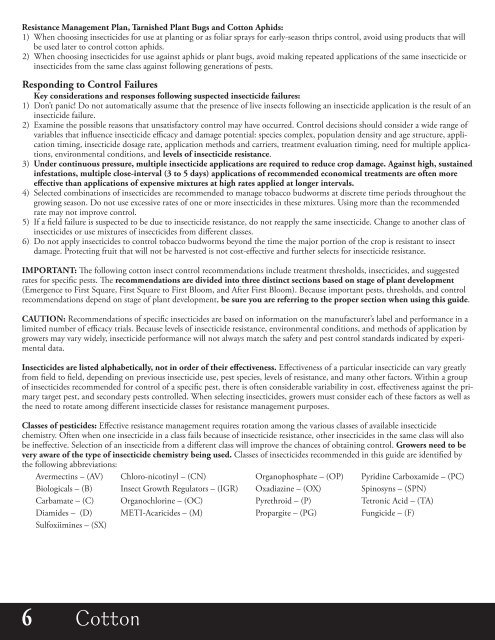Agronomic Crops
mJyPrJ
mJyPrJ
Create successful ePaper yourself
Turn your PDF publications into a flip-book with our unique Google optimized e-Paper software.
Resistance Management Plan, tarnished Plant Bugs and Cotton Aphids:<br />
1) When choosing insecticides for use at planting or as foliar sprays for early-season thrips control, avoid using products that will<br />
be used later to control cotton aphids.<br />
2) When choosing insecticides for use against aphids or plant bugs, avoid making repeated applications of the same insecticide or<br />
insecticides from the same class against following generations of pests.<br />
Responding to Control Failures<br />
Key considerations and responses following suspected insecticide failures:<br />
1) Don’t panic! Do not automatically assume that the presence of live insects following an insecticide application is the result of an<br />
insecticide failure.<br />
2) Examine the possible reasons that unsatisfactory control may have occurred. Control decisions should consider a wide range of<br />
variables that influence insecticide efficacy and damage potential: species complex, population density and age structure, application<br />
timing, insecticide dosage rate, application methods and carriers, treatment evaluation timing, need for multiple applications,<br />
environmental conditions, and levels of insecticide resistance.<br />
3) Under continuous pressure, multiple insecticide applications are required to reduce crop damage. Against high, sustained<br />
infestations, multiple close-interval (3 to 5 days) applications of recommended economical treatments are often more<br />
effective than applications of expensive mixtures at high rates applied at longer intervals.<br />
4) Selected combinations of insecticides are recommended to manage tobacco budworms at discrete time periods throughout the<br />
growing season. Do not use excessive rates of one or more insecticides in these mixtures. Using more than the recommended<br />
rate may not improve control.<br />
5) If a field failure is suspected to be due to insecticide resistance, do not reapply the same insecticide. Change to another class of<br />
insecticides or use mixtures of insecticides from different classes.<br />
6) Do not apply insecticides to control tobacco budworms beyond the time the major portion of the crop is resistant to insect<br />
damage. Protecting fruit that will not be harvested is not cost-effective and further selects for insecticide resistance.<br />
IMPoRtAnt: e following cotton insect control recommendations include treatment thresholds, insecticides, and suggested<br />
rates for specific pests. e recommendations are divided into three distinct sections based on stage of plant development<br />
(Emergence to First Square, First Square to First Bloom, and After First Bloom). Because important pests, thresholds, and control<br />
recommendations depend on stage of plant development, be sure you are referring to the proper section when using this guide.<br />
CAUtIon: Recommendations of specific insecticides are based on information on the manufacturer’s label and performance in a<br />
limited number of efficacy trials. Because levels of insecticide resistance, environmental conditions, and methods of application by<br />
growers may vary widely, insecticide performance will not always match the safety and pest control standards indicated by experimental<br />
data.<br />
Insecticides are listed alphabetically, not in order of their effectiveness. Effectiveness of a particular insecticide can vary greatly<br />
from field to field, depending on previous insecticide use, pest species, levels of resistance, and many other factors. Within a group<br />
of insecticides recommended for control of a specific pest, there is often considerable variability in cost, effectiveness against the primary<br />
target pest, and secondary pests controlled. When selecting insecticides, growers must consider each of these factors as well as<br />
the need to rotate among different insecticide classes for resistance management purposes.<br />
Classes of pesticides: Effective resistance management requires rotation among the various classes of available insecticide<br />
chemistry. Often when one insecticide in a class fails because of insecticide resistance, other insecticides in the same class will also<br />
be ineffective. Selection of an insecticide from a different class will improve the chances of obtaining control. Growers need to be<br />
very aware of the type of insecticide chemistry being used. Classes of insecticides recommended in this guide are identified by<br />
the following abbreviations:<br />
Avermectins – (AV) Chloro-nicotinyl – (CN) Organophosphate – (OP) Pyridine Carboxamide – (PC)<br />
Biologicals – (B) Insect Growth Regulators – (IGR) Oxadiazine – (OX) Spinosyns – (SPN)<br />
Carbamate – (C) Organochlorine – (OC) Pyrethroid – (P) Tetronic Acid – (TA)<br />
Diamides – (D) METI-Acaricides – (M) Propargite – (PG) Fungicide – (F)<br />
Sulfoxiimines – (SX)<br />
6 Crop Cotton Name


